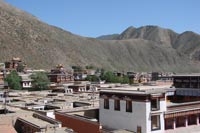




Labrang, a large and historically important Tibetan Buddhist monastery in China’s central Gansu province, is finding its activities and enrollment increasingly restricted by Chinese policy.
“Year by year, the practice of teaching and studying of the Dharma [the Buddhist religion] is deteriorating. It’s not getting better,” Jigme Gyatso, a monk living at Labrang, told RFA’s Tibetan service.
Though Chinese law permits freedom of religious faith and practice, Gyatso said, Chinese authorities force Labrang monks to make statements denouncing Tibet’s exiled spiritual leader, the Dalai Lama. This violates “one fundamental aspect of our being, the connection with one’s lama,” or religious teacher, Gyatso said.
“They require lamas and monks to denounce and criticize His Holiness and make them attend [political] education programs. Not only that, they come to the monastery to conduct searches and take away any photos of His Holiness the Dalai Lama they find.”
“So, in this way, they don’t allow us religious faith and practice,” Gyatso said.

Labrang, with an official population of about 1,300 monks, was formerly supported by income from its herds of cattle and sheep, grazing lands, and woodlands, said Gyatso. These have all been “confiscated and lost,” he said, and the monastery is now supported mainly by donations from tourists and pilgrims.
Only those monks who are officially registered can attend formal religious assemblies and prayers and receive support, Gyatso said. Others are forbidden to attend, and therefore have no means of livelihood.
They face hardship in supporting and maintaining themselves. This is either because they have not gained official registration in the monastery or because they have been here for a couple of years studying the scriptures independently, and their homes and parents are far away....Many...have been forced to return home.
“They face hardship in supporting and maintaining themselves,” Gyatso said. “This is either because they have not gained official registration in the monastery or because they have been here for a couple of years studying the scriptures independently, and their homes and parents are far away.”
“And in the absence of other sources of maintenance, they suffer immense privations and hardship, whether with respect to their clothes or food for survival. There are many such cases. There are also many who have been forced to return home.”
Restrictions on the numbers of new monks allowed to register have “negatively impacted” the continuity of monastic training, Gyatso added.
“As monks graduate to higher classes year by year, the lower classes are deprived of new monks to continue the studies and training,” Gyatso said. “This is very harmful.”
Provincial religious affairs officials couldn't be reached for comment.
Paul Nietupski, a scholar of Asian religions and cultures at John Carroll University in Cleveland, Ohio, said that Labrang, founded in 1709, quickly grew to be one of “the largest monasteries in all of Tibetan culture, [housing] somewhere between 4,000 and 5,000 monks, depending on the time of year and what kind of teachings were going on.”
“Some of the greatest Tibetan writers and scholars studied and worked and lived at Labrang,” Nietupski told RFA in an interview.
Though Labrang is located in China’s Gansu province, “it’s a Tibetan homeland,” said Nietupski, who has traveled several times to the region. “It’s always been a Tibetan homeland. It’s highlands, primarily nomadic territory.”
“The issue with Tibetan Buddhism in all parts of China, and at Labrang, is that people have a sense of Tibetan nationalism that is perceived as a threat by the central government of China,” Nietupski said.
Chinese authorities are “very sensitive about these issues,” Nietupski added.
The U.S. State Department, in its just-released 2006 report on human rights worldwide, said Chinese government officials have “closely associated Buddhist monasteries with proindependence activism in Tibetan areas of China.”
“The level of repression in Tibetan areas remained high [during the year],” the State Department said in its report, “and the government’s record of respect for religious freedom remained poor.”
Original reporting by Palden Gyal for RFA’s Tibetan service. Director: Jigme Ngapo. Written in English with additional reporting by Richard Finney. Edited for the Web by Sarah Jackson-Han.